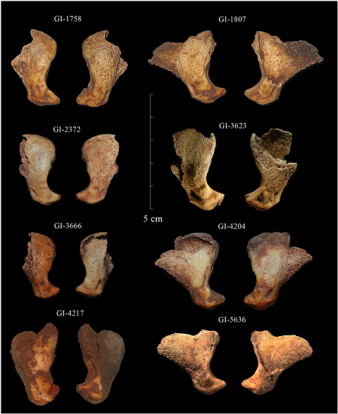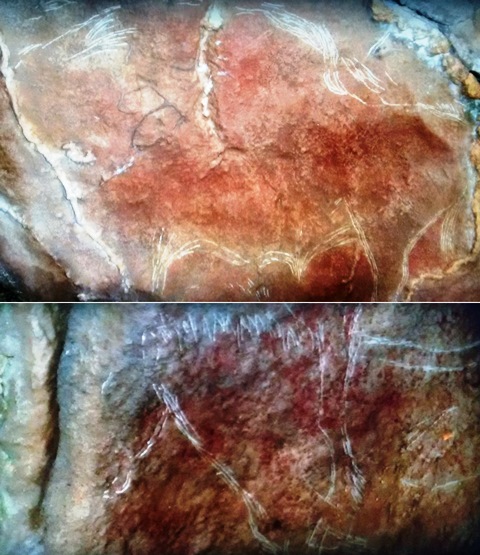This cave is located on La Garma Mountain, 5 km East from the Santander Bay, northern Spain. It is divided into various levels and was used since the Middle Paleolithic by hunter-gatherer groups.
The oldest evidences of human presence are dated to 400,000 years and come from the ancient cave entrance (it may have been an open shelter) called La Garma A. This area has also presence from the Mousterian period, with many lithic objects, fauna remains and one hearth of c. 70-80 Ka.
The most iconic finds correspond to the Upper Paleolithic, particularly in the period between 36-16 Ka around the Last Glacial Maximum. In total, more than 200,000 objects related to human presence have been identified at La Garma up to date.
- The upper hall (La Garma A) shows a continuous human presence from several periods: pre-Mousterian, Mousterian, Aurignacian, and also Magdalenian with human burial sites, spear points and one harpoon. As earliest materials, a first cervical vertebra of a rhino was announced in 2015 with an estimated dating of 400 ka, and in 2018 many handaxes and fauna remains were recovered (with special mention to bones of the extinct elephant Palaeoloxodon antiquus). In 2019 the dating of c. 400 ka for these materials has been confirmed.
- The intermediate gallery has a large number of paleontological remains, mainly bones. It also contains four series of red disks painted over stalagmite pillars from the Magdalenian.
- The most important remains are on the lower gallery, where three intact areas contain many examples of archeological remains, objects and rock art. Some 13,000 years ago a collapse blocked the lower level entry and locked out the cave like a time capsule: the floor remained exactly as it was, covered by bones, pieces of flint, and other objects left by Magdalenian humans. The cave was over 300 meters long, with huts, paintings, engravings and archeological remains on the surface of the cave floor.
The lower gallery
This area is huge (535 m2) and full of remains of habitational, industrial and artistic use. Many objects of great scientific and archeological interest were discovered here.
A row of stones were built forming a ring next to the west cave wall, marking a structure about 130 meters from the entrance. This stone wall must have served to prop wooden poles or branches, where it was tied and supported a fur envelope of animal skins, creating a space within the cave, a kind of hut. Stalagmites that are grown over the stones indicate the age of the structure.
Outside the structure, waste material was accumulated: bones (mandibles, a horse skull), flint objects, needles, a pendant decorated with geometric patterns, a neck with sea shells… Many artistic objects have been found at this level.
Nine distal phalanxes of cave lions (Panthera spelaea) were also found at zone 4 of the lower gallery. The bones indicate a patterned modification due to precise cuts at the distal interphalangeal joint, for the disarticulation of both phalanxes. This requires reiterate action and experienced human skills, which are also used today by modern hunters when skinning their prey, when the aim is to keep the claws attached to the fur. This evidence, together with the absence of other lion bones and the spatial distribution, may suggest a cave lion skin extended as a structure cover.
This is the latest evidence of cave lion exploitation in the Iberian Peninsula, 14,800 years ago. The association of this evidence with the ritual activities and the human structures at zone 4, may provide an explanation to cave lion extinction during the Late Pleistocene.
Portable art at La Garma
Some remarkable examples of portable art are four perforated batons, spatulas, awls, spear points, many decorated lithic tools and mollusk shells. Four objects are outstanding works of the Paleolithic portable art:
- A spatula decorated with the figure of a ibex was found next to the cave wall. It was made from an aurochs or bison rib, and its curved, sharpened end clearly shows signs of its use. It was decorated with ochre which remained incrusted in the small angled fissures. In the upper part, an ibex is represented on both sides of the spatula in a spectacular display of the Magdalenian artistic skill.
- A shaped cut out made from a horse hyoid bone. The artist was able to structure an ibex head on this material, and then work on both sides to sketch the anatomical details of the animal, like the beard, snout, nostrils, eyes and ridges of the horns.
- The incisor of a horse sharpened, scrapped, polished and decorated with a glacially graved horse’s head.
- An aurochs phalanx which is engraved with three figures: a male aurochs, an arrow-shaped sign and an anthropomorphic figure. The quality of the engraving is exceptional [further info on this object]
Rock art at La Garma
There are over 60 animal figures represented: bison, horse, goat, deer, aurochs, giant deer and one mask painted on rock relief which remembers those from other Cantabrian caves, like Altamira and El Castillo.
From the Gravettian (25-19 Ka) there are 43 hands painted in negative. From the Solutrean and Magdalenian (19 to 13 Ka) there are some paintings of aurochs, goat, giant deer and bison.
Around the hut structure in zone 1 we can see a spectacular panel:
- At first sight some red signs can me made out.
- On the one side there are some dots and a grill-shaped sign.
- In a more interior area, a bison is represented using the shape and volume of the roof.
- Another one is seen on the front, with its head, horns and eye represented in profile.
- Excellent fine engravings are decorating the roof of the hut. In one sector, the head, back and belly of an elegant bison were drawn, with fine lines represented the animal shape and coat.
- Very near, beneath the body of a deer, a well-defined horse’s head can be seen, framed by engravings depicting the long hair of its neck.
- Horses are in fact the most common animal represented on this part of the cave: in another sector of the roof, the full outline is magnificently drawn with fine repeated lines, above which a further silhouette of a horse was depicted more simply.
And human footprints!
Recent works have yielded a group of 14 human footprints dated to the Middle Magdalenian (c. 16,5 ka). Their length (18 cm) corresponds to a 6-7 year-old child. The number of individuals is not yet estimated.
They are located 300 meters inside today’s cave entrance, on a site 25 metres above the Lower Gallery that had hardly been studied before.
There are several heel prints which do not include the rest of the foot, perhaps suggesting a child’s game. The footprints were announced in May 2021, pending to further research.
[1] Cueto M, Camarós E, Castaños P, Ontañón R, Arias P (2016) Under the Skin of a Lion: Unique Evidence of Upper Paleolithic Exploitation and Use of Cave Lion (Panthera spelaea) from the Lower Gallery of La Garma (Spain). PLoS ONE 11(10): e0163591. doi:10.1371/journal.pone.0163591 [link]








Hello
Is palaeoanthropology becoming focused on ADN extraction rather than fossil hunting?
Me gustaMe gusta
Hello. Of course, genetics is becoming very important to understand human evolution. But, don’t worry, paleoanthropologists have not given up fossil hunting 🙂
Me gustaMe gusta
Thanks Roberto muchas gracias
…for keeping your readers so updated in so pertinent issues of paleo
Me gustaMe gusta
Thank you!
Me gustaMe gusta
Very interesting! Thanks for including the signs and carvings as well as the animal figures.
Me gustaLe gusta a 1 persona
Thank you for your comments
Me gustaMe gusta